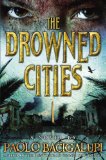by Paolo Bacigalupi
Little, Brown and Company, 2012. 437 pages.
The Drowned Cities is set in the same world as Ship Breaker, but you definitely don’t need to read Ship Breaker first. The Drowned Cities is an even bleaker vision of the future than the first book. There’s still action and survival, but no love story and few glimpses that anyone in the world has it better than the characters in our story — so can they really hope for escape?
It took me awhile to realize that “The Drowned Cities” got their name as a new meaning for the initials “DC.” This book is set in a future world where global warming has raised sea level and turned the DC suburbs, now that things don’t freeze in the winter, into kudzu-covered jungle and swampland.
Mahlia and her friend mouse live with Doctor Mahfouz in a village in the jungle. It’s also a war zone, fought over by various warlords’ factions.
Doctor Mahfouz liked to say that everyone wanted to be good. They just sometimes needed help finding their way to it. That was when he’d first taken her and Mouse in. He’d said it even as he was sprinkling sulfa powder over Mahlia’s bloody stump of a hand, like he couldn’t see what was happening right in front of him. The Drowned Cities were busy tearing themselves apart once again, but here the doctor was still talking about how people wanted to be kind and good.
Mahlia and Mouse had just looked at each other, and didn’t say anything. If the doctor was fool enough to let them stay, he could babble whatever crazy talk he wanted.
In a nice touch of irony, the author has made Mahlia a daughter of a Chinese peacekeeper and a local woman. And Mahlia and her mother were left behind when the peacekeepers left.
These days, their hospital was wherever Doctor Mahfouz set his medical bag, all that was left of the wonderful hospital that the Chinese had donated, except for a few rehydration packets still stamped with the words WITH WISHES FOR PEACE AND WELL-BEING FROM THE PEOPLE OF BEIJING.
Mahlia could imagine all those Chinese people in their far-off country donating to the war victims of the Drowned Cities. All of them rich enough to send things like rice and clothes and rehydration packets all the way over the pole on fast-sailing clipper ships. All of them rich enough to meddle where they didn’t belong.
Mahlia and Mouse find a genetically engineered half-man out in the swamp who just wrestled an alligator and survived. First, Mahlia’s bargaining with him — Mouse’s life for medical supplies, and then she’s dealing with the war band that is on his trail. In a clever twist, Mahlia manages to get away from them, but her whole village pays the price. And when Mouse gets conscripted, Mahlia will do anything to save him — even if it means relying on the half-man. But even with his help, is there any escape from the Drowned Cities?
This book is far grittier than I usually read for pleasure. It’s a horribly bleak vision of the future, though from his Printz speech, I think Paolo Bacigalupi writes it as a warning. And several things are all too plausible. The factions include the Army of God and the United Patriotic Front and other groups that are like present-day groups taken to the extreme.
I think the fact that I live where the book is set (though many years before) makes it seem all the more real. I have to admit that the day I finished the book, I was driving home from work on the freeway, and thought it’s all way too built up and there’s too much concrete to become jungle for at least a thousand years. However, the following Sunday, I drove the opposite direction to church, and just that much further out in the suburbs, it’s actually easy to imagine jungle taking over. And Paolo Bacigalupi never does say how far out from the Capital they are. It takes awhile to travel to the city, and after all, they’re called “The Drowned Cities,” not “The Drowned City,” so I’m thinking the villages in the jungle may be further out from the Beltway than where I live.
The book does have some redeeming themes. There’s no romantic love, as in Ship Breaker, but there’s strong love and loyalty between Mahlia and Mouse, and they get help from the half-man, Tool, for reasons of his own. It does manage to give a hopeful ending, at least for those who survive to the end. And if you want reasons to think war is not a good thing and it’s better not to vilify other groups, because look where it could end up — This book has plenty of that.
This book might be good for those who love The Hunger Games and don’t mind some grit and gore in their adventure stories, and also don’t mind if there’s no romance. Definitely well-written, but also definitely not pleasant.
Find this review on Sonderbooks at: www.sonderbooks.com/Teens/drowned_cities.html
Disclosure: I am an Amazon Affiliate, and will earn a small percentage if you order a book on Amazon after clicking through from my site.
Source: This review is based on a library book from the Fairfax County Public Library.
Disclaimer: I am a professional librarian, but I write the posts for my website and blogs entirely on my own time. The views expressed are solely my own, and in no way represent the official views of my employer or of any committee or group of which I am part.
Please use the comments if you’ve read the book and want to discuss spoilers!
